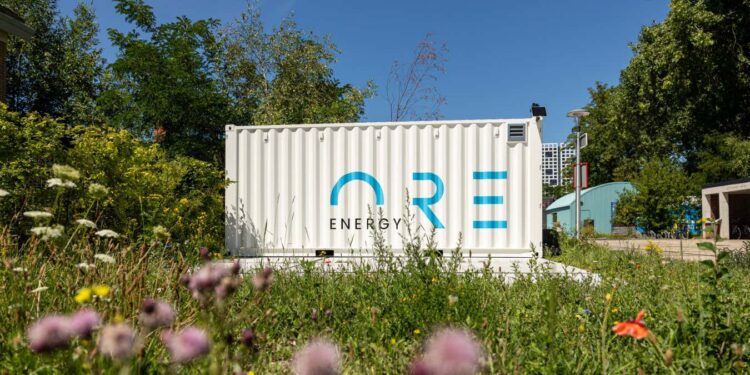
A rust-based battery system is stored in standard 12-metre shipping containers
Ore Energy
An iron-air battery that stores and releases energy through a reversible rusting process has become the first of its kind to connect with a public electricity grid. On 30 July, the Dutch startup Ore Energy announced its batteries had connected to the grid at Delft University of Technology in the Netherlands.
Batteries can help deliver a consistent supply of electricity by storing renewable energy from solar or wind farms, releasing it when necessary to ensure that a sudden change in sunlight or wind doesn’t mean an immediate drop in available electricity.
“You need to be able to store that excess energy when the wind is blowing and the sun is shining, to be able to deploy it when you need to during critical demand periods during the day,” says John-Joseph Marie at The Faraday Institution, a battery research body in the UK. “Essentially, batteries can help to smooth out that power output to make it usable on the grid.”
Many grid-connected batteries are now lithium iron phosphate ones manufactured in China. But they typically hold power for just 4 to 6 hours and are prohibitively expensive, says Marie. In contrast, the iron-air batteries developed by Ore Energy can store power for 100 hours or longer and are made from cheap and widely available materials.
“Iron is the most mined metal in the world, it’s incredibly cheap,” says Marie. “And when you combine that with air, which is literally all around us and basically free, those are almost the two cheapest components that you could find.”
The system charges and stores energy by using electricity to convert iron oxides – a form of rust – into metallic iron. The iron can then discharge or release its stored energy by chemically reacting with oxygen from the air to form rust again.
“When the battery is discharging, we are actually taking the iron and turning it into a special type of rust,” says Aytac Yilmaz, CEO of Ore Energy. “And when we are charging the battery, we are taking the rust back into iron, and we do this over and over again [while] the battery is breathing in and out the oxygen from atmospheric air.”
The batteries are stored in standard 12-metre shipping containers and can store multiple megawatt-hours of energy – with 1 megawatt-hour being enough to supply more than a month of electricity to a typical US home.
Separately, the Massachusetts-based company Form Energy has several US iron-air battery projects in the works. They are slated for installation in New England and the US Midwest.
In addition to iron and air, such batteries incorporate water-based electrolytes that are also cheap and abundant – not to mention greatly reducing the risk of battery fires. “I wouldn’t want to be the one to say never, but you can’t set fire to water,” says Marie.
But the main goal of the battery technology is to help renewable power sources replace fossil fuels in electricity grids.
“Energy companies still rely a lot on gas-fired [power] generation to provide the flexibility needed when wind and solar are not sufficient,” says Bas Kil, business development manager at Ore Energy. “But in the long term we will need a different type of flexibility, and that is where our battery really excels – to provide this multi-day flexibility.”
Topics:
Source link : https://www.newscientist.com/article/2490293-rust-based-battery-connects-to-an-electricity-grid-for-the-first-time/?utm_campaign=RSS%7CNSNS&utm_source=NSNS&utm_medium=RSS&utm_content=home
Author :
Publish date : 2025-07-30 08:00:00
Copyright for syndicated content belongs to the linked Source.














